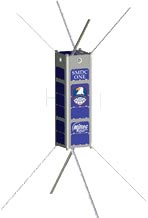The first batch of eight SMDC-ONE nano-satellites developed and built by Miltec Corp. for the U.S. Army Space and Missile Defense Command (SMDC) was delivered this week to the Army customer at Huntsville, Alabama. The program’s goal is to demonstrate how a constellation of miniature, low-cost nano-satellites spacecraft, each costs about $400,000 perform six months in space, effectively extending tactical communications over-the-horizon.
These miniature satellites, each weighing about four kilograms, are designed to test the performance of nano satellites performing communications data relay missions. The first satellite will be launched in 2009 to be followed by the remaining group of seven being launched at a later date to form a nano-satellite constellation. The Army plans to insert a number of nano-satellites into low earth orbit together, to evaluate their effectiveness in enhancing tactical communications capability.
While the current satellites are designed to perform simple communications relay missions, future versions are being planned with on-board GPS capability for greater autonomy, an additional S-Band communications link supporting higher data transmission capacity, and an embedded software defined radio (SDR) core providing for greater transceiver frequency flexibility and more flexibility supporting diverse radio standards.
According to the Army, because the unit cost for a nanosat is relatively low (less than $1 million per satellite), large numbers for each specific mission could be built and deployed. What a nanosat may lack in performance and reliability when compared on a per-unit basis to a large traditional military satellite, it makes up by its low cost and potential for persistent presence over given theaters of operations through constellation proliferation. A nanosat constellation populated by inexpensive spacecraft could be useful in humanitarian support, stability and support operations and nation building. If a satellite ceases to function, it could be rapidly reconstituted. nanosats can provide coverage across specific regions, as well as globally. The use of nanosats in such a fashion will enable UAV-like performance for communication from spaceborne assets that can provide data directly into theaters of operation.

















